| WARNING: Some of the photos are a bit gory, and one shows explicit lion sex. |
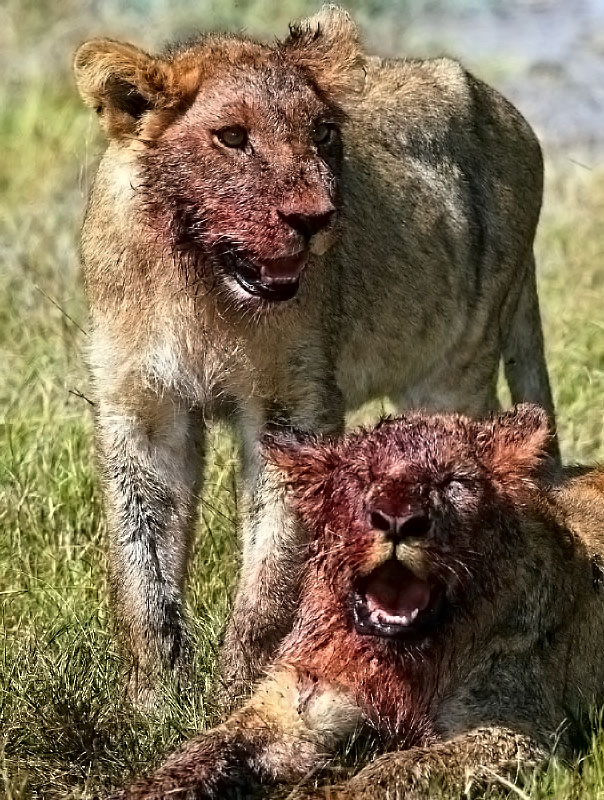 |
| lion cubs bloody |
| Lions are the only truly social cat, living in groups called prides. A pride is a set of females, often but not always sisters, along with their cubs and subadult cubs. There are also one or more males, usually a coalition of two brothers, but sometimes unrelated lions. Lionesses are the backbone of the pride—they stay together for many years. Males tend to come and go—the typical time frame for them dominating a pride is just 3 to 4 years. Upon reaching adulthood female cubs may stay with the pride. Males never do—they disperse and become nomadic, looking for a pride where they can challenge the dominant male and take over. |
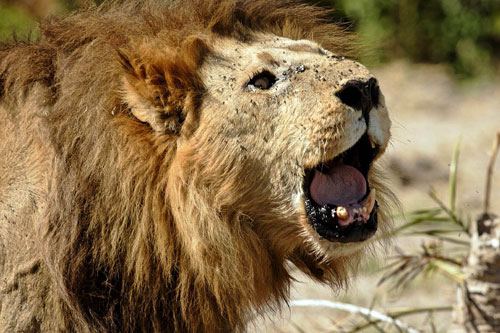 |
| lion roaring |
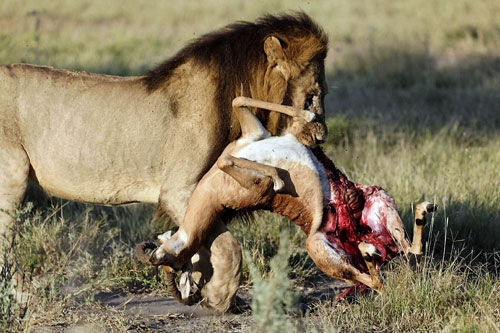 |
| lion carrying impala |
|
Male lions really look the part of the "king of beasts". Their lives are full of violence, exploitation and sex—in other words just like human royalty through much of history. Male lions sleep an average 20 hours per day. The females on the other hand do all of the really hard work—killing the majority of prey, which the males then appropriate for themselves. The main danger males face is fighting off other males that want to take over their pride and territory. This is serious business; most male lions die in such fights. In between territory fights they are bad tempered and terrorize the females in their pride. In short, they have the lifestyle of pimps. |
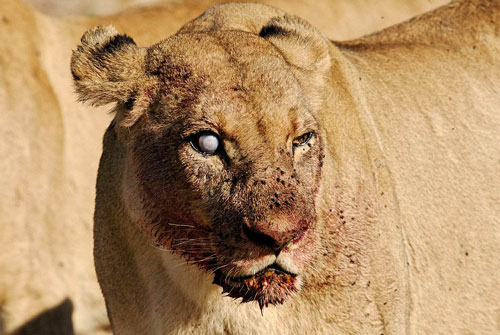 |
| silver eye |
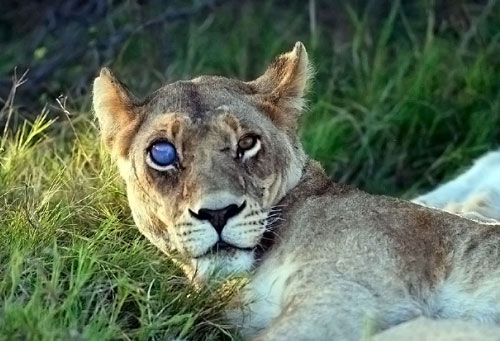 |
| lioness evil eye |
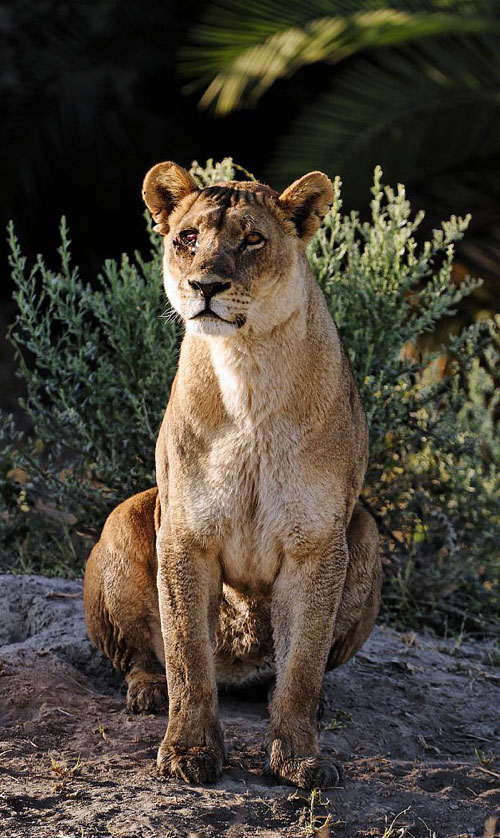 |
| lioness with wounded eye |
| Females, on the other hand are sleek efficient hunters. They must kill most of the prey, which is very dangerous work. I saw three lionesses that had each lost an eye. One, which the guides call Silver Eye is the most aggressive hunter in her pride. In another area we saw a lioness dubbed "Evil Eye" who had a similar but much more recent eye problem. The eye was still swollen, giving her a demonic look, a bit like villains in Japanese Anime. I also saw a lioness which had lost her eye in the last couple days—the socket was still oozing blood. Each of the lionesses had lost their right eye, which suggests to me that lions might be right handed—technically this is called laterality. Presumably right favoring lions would approach prey preferentially from the right, leading to more right side injuries. Of course, a sample size of three is too small to make a firm conclusion. |
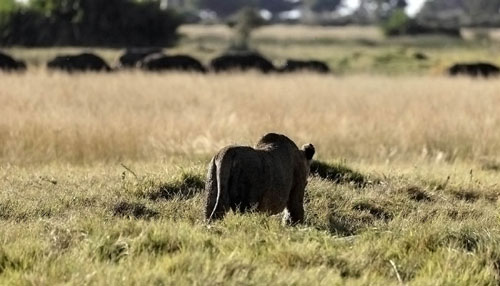 |
| lion stalking |
| One of the places I visited is Duba Plains, an island in the Okavango Delta of Botswana. The island has a herd of about 600 Cape buffalo, and a pride of ten lions. Both the buffalo and the lion got there about a decade ago in a year when crossing channels was possible—since then both have pretty much been trapped on the island. For reasons nobody fully understands, the Duba lions only hunt during daylight—the reverse of the situation in most parts of Africa. So you go to Duba to see one thing—lions hunting killing buffalo. I spent five days doing this, and it was quite an experience. |
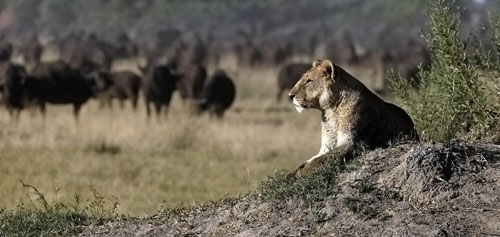 |
| lioness watching herd |
|
Anybody who has seen a documentary "knows" that lions hunt cooperatively to bring down prey. Unfortunately, nobody seems to have told the lions this. Indeed, for many years field biologists who study lions have realized that cooperative hunting is an illusion. The naturalist George Shaller figured this out in the late 1960s with the first quantitative field study. He found that a single lion has a success rate of 15% on a given hunt—or about one successful hunt for every seven. Two lions have a success of 29%, which is 3% LESS successful than if the two lions with 15% individual success hunted by themselves (32.2%). Three lions get 27%, or 2% less than two lions. Four, five and six lions get 32% - meaning that they are (finally) as successful as sending two lions out by themselves. There is clearly no statistical value to hunting in groups.
More recent studies by Craig Packer and others have looked at higher order statistics—the variance, or the size of the animal. It all comes out the same way. If indeed lions hunt in some cooperative and strategic way, then they get no benefit from it statistically. So, how come the Discovery Channel says they are cooperative? Partly it is because these figures are buried in Appendix B of Shaller's book, or in dense academic papers. Mostly it is because the story of cooperative strategy in hunting is so endearing to people. Especially to film editors, which means we are destined to seeing cooperation in every nature documentary. The cases where the hunting fails due to lack of cooperation end up on the cutting room floor. Watching lions hunt, the trends are quite obvious. The primary reason that groups of lions are no more effective than two by themselves is that typically only two lions do the actual hunting. They all make a show of hunting, but in the cases I watched, in several different prides, there were always a couple females that were the most aggressive and took the lead. The others hang back for the hard part then rush up at the end after the worst danger is over. Their primary goal is to be at the kill early so they can eat, not to actually help. Field studies have confirmed that lions do not seem to keep track of this and punish slackers. Lions can seem quite inept at hunting, because they have no way to communicate complicated information. The Discovery Channel case happens when one lion flushes prey in past another for a perfect catch. More often, what happens is than one lion blows it and scares the game too early, or flushes it in the opposite direction. After watching hunt after hunt fail, you soon decide that Iions are not very coordinated. Indeed their only saving grace is that the buffalo can't communicate very well either. |
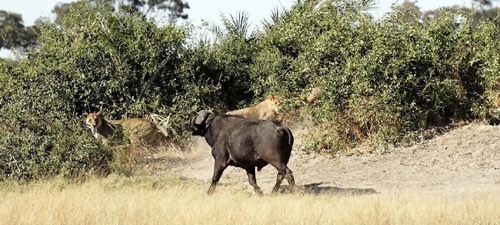 |
| buffalo charging lions |
| Buffalo are quite impressive animals. They are very brave and will not hesitate to attack lions when they can. When one buffalo has been knocked down by lions, the buffalo herd will almost always attempt a rescue—charging in to drive the lions away. This succeeds a large fraction of the time—even if the buffalo has been down for 30 minutes. Of course if the buffalo herd surrounded the lions when they were sleeping and just methodically trampled them to death, their whole problem would be over, but there is no buffalo general to lead them in such an endeavor. Alternatively, if the buffalo had a bit more skill at rounding up the herd, they'd never leave some separated which is what the lions look for. |
 |
| lioness in shadow |
| Even a buffalo separated from the herd has reasonable chances. At one point we saw a lone bull that was trying to get back to the herd, which was about a half mile away. In between him and the herd were four lionesses, sacked out asleep. This looked like the perfect opportunity for a kill, but the buffalo surprised both us and the lions. He crept up on the sleeping lions, then when he got close he lowered his horns and charged. The lions awoke, panicked and scattered into the bushes. The buffalo then trotted victorious back to the pride. It was a perfect illustration of the adage that the best defense is a good offense. |
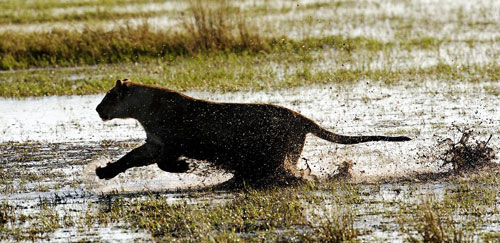 |
| lioness running |
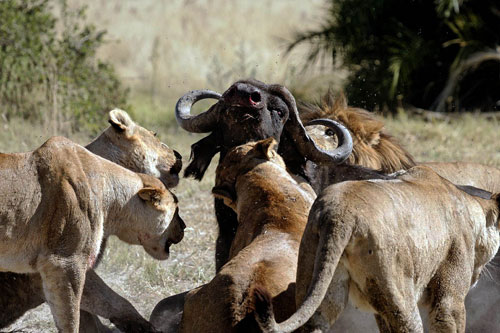 |
| lions bringing down buffalo |
| In order to catch a buffalo a lion must jump on the buffalo's back, and do to that they need to get past the horns. It's the same problem that a Spanish matador faces in bullfighting. The matador has a huge advantage however—his cape distracts the bull who tries to gore the center of the cape, allowing the matador to slip by. Lions don't have capes, and as a result they cannot approach a buffalo from the front—they must jump on the back from the side or behind. Once on the back, the lion hangs on for dear life, a bit like a cowboy riding a bull. The goal is to get the buffalo to stumble. If there is more than one lion hunting this is the point when they will start to pile on. |
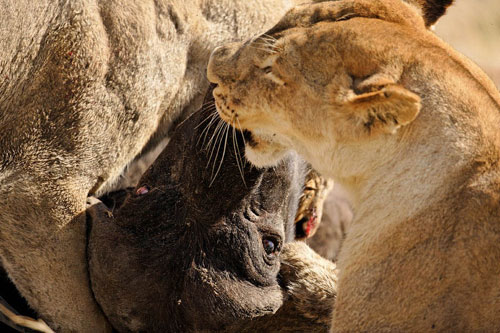 |
| lion nose biting buffalo |
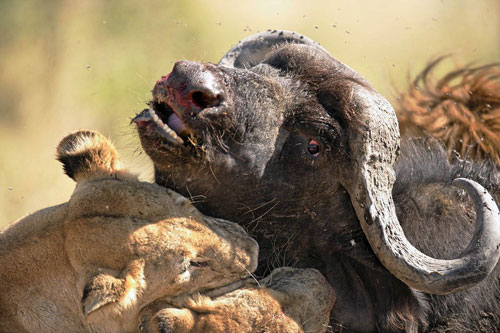 |
| lion bringing down buffalo |
| Often the buffalo just shrugs the lions off, and that is that. However if the buffalo falls down, things get much more serious. Some cats kill instantly with a bite that dislocates cervical vertebrae, severing the spinal cord—for example, cougars in the US. This is not the case for lions, they are stranglers or suffocators. They either bite the underside of the neck to collapse the trachea. Or they put their entire mouth over the prey animal's nose. Either way it is a relatively slow suffocation that kills the animal. This can take 30 minutes, or even an hour for a buffalo because they can't get enough pressure on the huge buffalo neck to close it all the way, or can't get a good seal on the nose. This is not the quick merciful picture that one sees in nature documentaries. If the buffalo gets up during that period he or she may get away with only some minor mauling. |
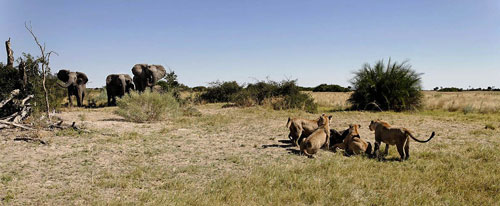 |
| lion kill with elephants |
| At one of the kills a small herd of elephant came in to investigate. They clearly were thinking about rescuing the buffalo—they trumpeted and the herd matriarch ripped a tree of out the ground to impress the lions. It certainly impressed me! The lions were clearly concerned, and if they had been attacking an elephant calf they would have been in trouble. After a tense showdown the elephants decided it wasn't their fight and walked away. |
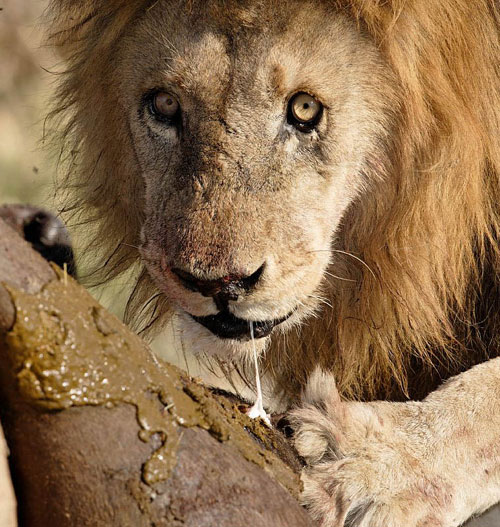 |
| lion male on buffalo |
| Lions don't wait to kill the animal before starting the process of eating it—as soon as the buffalo stops thrashing, lions start to eat. This is much harder than it sounds however, because the hide is very thick. The prime spot to start is always claimed by the dominant female, or if the male is there, he takes the prime spot. The prime spot is not what you might thing—it is the rectum. Believe it or not, the king of beasts starts his dinner by carefully licking the rectum clean. Since the buffalo defecates while dying this is a bit messy. The lion then works very hard to gnaw through the skin and get an incision open. |
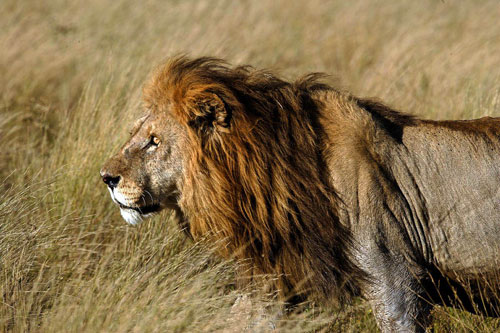 |
| lion male stalking |
| I was describing this to a friend over lunch in Palo Alto. As I was describing this the waiter came up behind me to take our order. I was in the middle of saying "it's very hard to enter the rectum, but once you do things move much faster", only to hear the waiter gasp. Whoops. I tried to explain saying "well, this is about" but with a horrified look he said "I do NOT want to know what this is about! Some people are just not interested in natural history, I guess. |
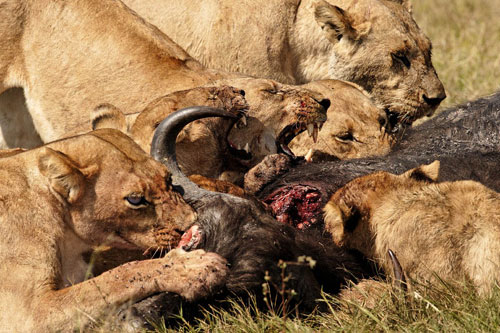 |
| lions eating 1 hour after kill |
| Once the carcass is opened the lions settle down to eat. This is punctuated by each lion growling, hissing and sometimes snapping at the lions around it. Lions are not polite eaters—they grab as much as they can for themselves in a pretty direct competition with the other lions. Usually one of the pride males shows up and when he does the females give it him a very berth—he can attack or maim them at any moment. If they want to eat close to him they approach carefully and try to mollify him with some social greeting and flirting. Cubs are usually a bit more tolerated by the male, but even they risk pushing too far. Cubs are quite enthusiastic eaters and seem to love a carcrass. Some enterprising cubs actually crawl inside the carcass and eat it from the inside out, leaving them drenched in blood afterward. |
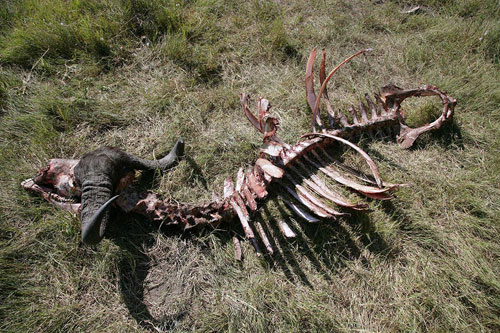 |
| buffalo after 24 hours |
|
Within a few hours the carcass has most of the meat gone, and within a day there is almost nothing left of even a large bull buffalo. Jackals, vultures and other scavengers move in for the scraps, but if there is a good sized pride of lions there isn't that much for them. If hyena are in the area then they will come and eat the bones, cracking them with specially adapted teeth to get the marrow and collagen from the bone.
Lion social life is very rich and complicated. In human terms it is very easy to see them as affectionate, because as social animals we share the practice of greetings with physical contact. We hug. They rub noses. These similarities make it easy to understand what is going on—or perhaps misunderstand because the translation from lion to human is not 100%. |
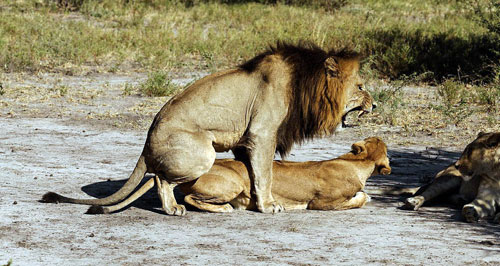 |
| lion sex |
| Lion sex is interesting to watch, but I fear that admission may tell you more about me than about them. So here is why it is interesting. many mammals, including humans, have regular estrus cycles, but lions have a different system. After cubs are weaned the female becomes interested in sex again and flirts outrageously with the male, wrapping her tail around his head and other things that are pretty unmistakable, even to a human observer. The happy couple then starts having sex - over and over and over again. Lions are stimulated ovulators; the female does not ovulate until she is stimulated to do so by lots of sex. As a result lions will mate roughly every 15 to 20 minutes for two or three days—200 to 300 times in succession. During that period they are inseparable and will not hunt or eat. They still need to drink but this is a bit problematic because if the male goes to drink then another male may sneak in. The regularity of the mating process is great for a photographer, because lion sex is over very fast. Although they surely win the prize for the number of repetitions, each time only takes a minute or so. You have to be all ready to get a good picture. |
 |
| lion male |
|
Lions are very compelling subjects to watch. This is especially true in Botswana where you are in open land rovers, often just a few feet away from them. When a wild lion, its face smeared with blood, is only a few feet away from you it is hard to keep your eyes of it—just like it is hard to avoid watching an open flame dance in a campfire. It's more than just the visual spectacle—there is something very ancient about our relationship to lions, a fascination with the dark side of nature. Or perhaps it is that we are both humans and lions are crown predators. Humans are one of the few creatures that lions fear, and they are of the few things we fear. Lions are magnificent animals —they can be cruel, brutal and gory, but they're also beautiful and fascinating. A bit like people, I suppose.
—Nathan
DR. NATHAN MYHRVOLD is CEO and managing director of Intellectual Ventures, a private entrepreneurial firm. Before Intellectual Ventures, Dr. Myhrvold spent 14 years at Microsoft Corporation. In addition to working directly for Bill Gates, he founded Microsoft Research and served as Chief Technology Officer.
|
 |
|
Nathan Myhrvold's Edge Bio Page
Photos copyright © 2007 by Nathan Myhrvold. All rights reserved. |

